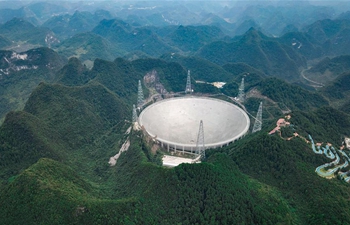Pang Xinghai, 55, originally planned to become a doctor or a soldier. But he failed the college entrance examination and enrolled in the Qinghai station of PMO in 1982.
"When the workers were building the telescope, they had to inhale oxygen to cope with the altitude," Pang recalls.
After working 36 years in the station, Pang will retire this year, but he's reluctant to leave. "Astronomers made many important discoveries through this telescope, and I also made a contribution," he says.
Li Zhenqiang graduated from university and came to work in the station in 2006. He lost almost half his hair in one year as he was not accustomed to the water and stayed up late.
He took postgraduate courses in PMO in east China's Jiangsu Province for two years - then chose to come back to the Qinghai station.
"I get a sense of achievement making discoveries from the telescope data," he says.
PORTRAIT OF GALAXY
In such a tough environment, Chinese astronomers carry out a grand and poetic project: painting a portrait of the vast Milky Way.
The Milky Way Imaging Scroll Painting project, led by Yang Ji, director of PMO, and launched in November 2011, is the largest project conducted with the 13.7-meter millimeter-wave telescope.
The Milky Way is an interesting subject for astronomers, due to the large number of stars and abundant gases in it. For a long time, scientists conducted observations, but mostly gathered fragmented data.
What's the detailed structure of the Milky Way? How do the stars form? How are the stars distributed? What is between stars? These are the mysteries of our galaxy.
The Milky Way Imaging Scroll Painting project aims to probe the distribution, structure and physical properties of molecular clouds to get a relatively complete picture of the structure of the Milky Way, Xu Ye says.
"The project will change our understanding of our galaxy," he says.
When the researchers finish observing one area of sky, they fill a small square on a chart hanging on the wall of their office. So far, they have filled more than 6,000 squares, meaning they have completed more than 60 percent of the project.
The observation and portrait of the whole galaxy is expected to be completed in another five years, says Xu.
"We can observe three molecular spectral lines that give us a clearer and more thorough picture of the celestial bodies. It's like we can see not only the eggshell but also the yolk and the white of the egg. The molecular spectral lines also contain information about the velocities of celestial bodies, so we can know whether they are moving toward us or away from us," Xu says.
A multi-beam receiver has been installed on the telescope to improve its observation ability by more than 50 times, Xu says.
The PMO plans to install a more advanced multi-beam receiver to observe the whole sky. It is also pushing forward the construction of a world-class submillimeter-wave radio telescope with a diameter of 60 meters, which can gaze to the edge of the universe more than 13 billion light years away, Xu says.

















